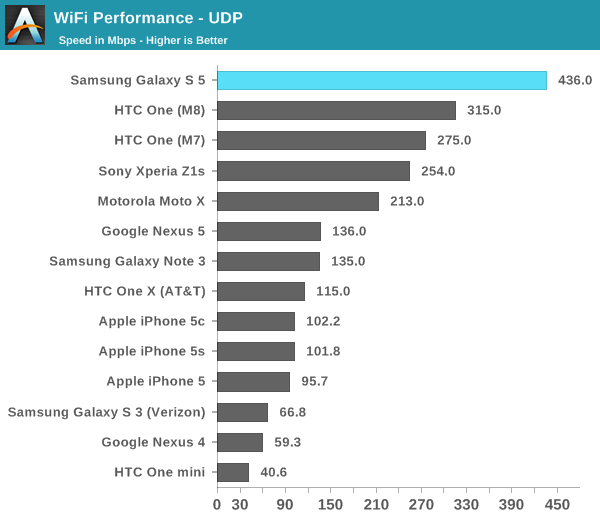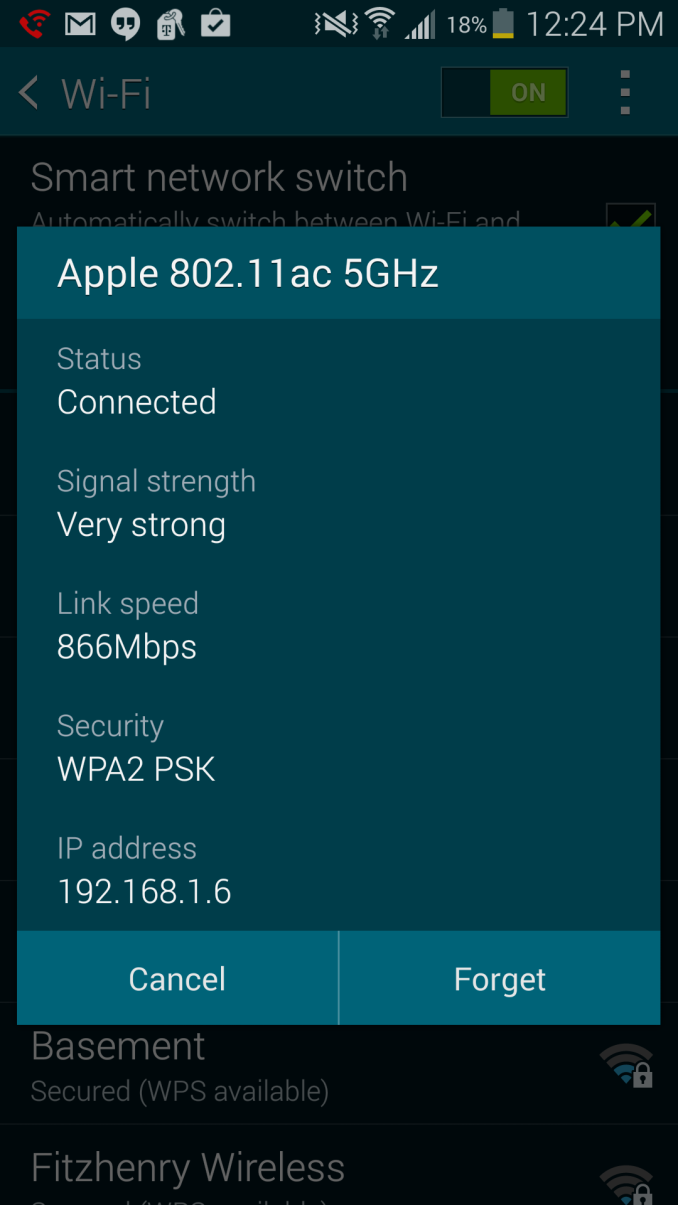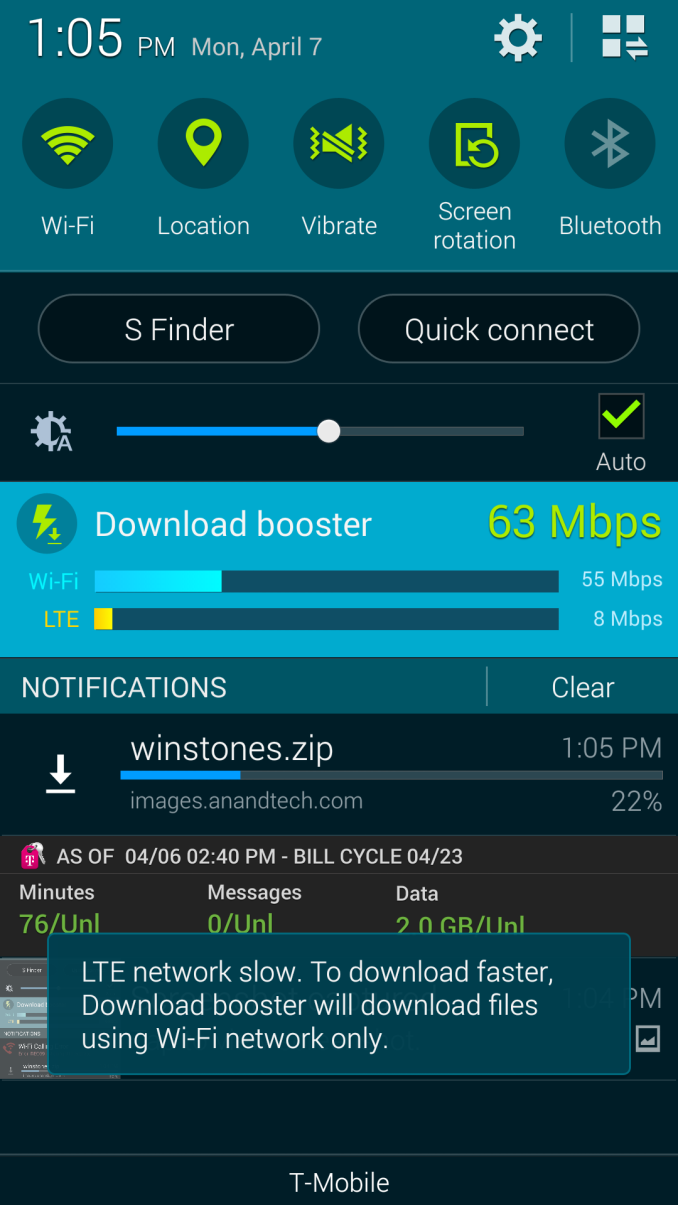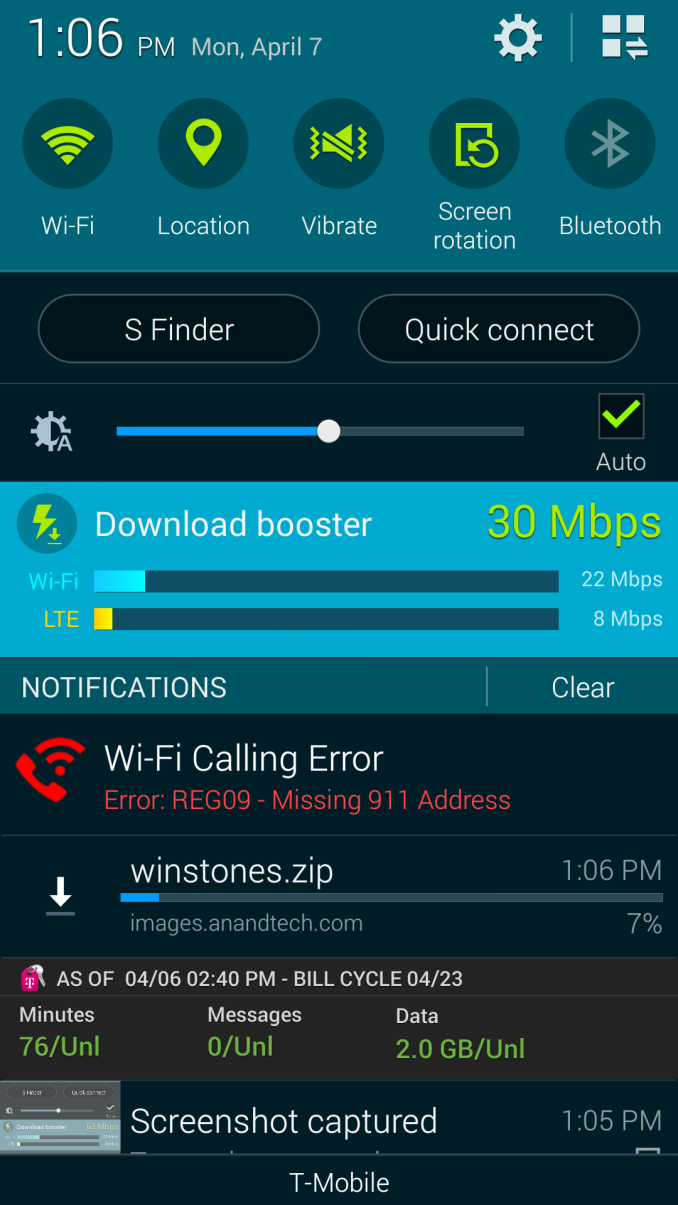Samsung Galaxy S 5 Review
by Anand Lal Shimpi & Joshua Ho on April 8, 2014 12:00 AM EST- Posted in
- Smartphones
- Samsung
- Mobile
- Galaxy S 5
WiFi, Cellular & Download Booster
At MWC this year Broadcom announced its BCM4354 802.11ac 2x2 MIMO WiFi combo chip for smartphones/tablets, which found its way into the GS5. The result is a smartphone capable of negotiating with an 802.11ac AP at 867Mbps, and transferring data at up to 436Mbps.
Although peak performance is nice, there are also power benefits to being able to transfer data quickly over WiFi (race to sleep applies to network interfaces as well).

The Snapdragon 801 features Qualcomm's integrated category 4 LTE 9x25 modem core. As I mentioned in our power analysis, Samsung also chose to include Qualcomm's QFE1100 envelope tracker (just like in the Galaxy Note 3). The GS5 is also the first flagship Samsung device to include support for 2 carrier aggregation on supported LTE networks. Samsung doesn't appear to be using Qualcomm's antenna tuner or any other RF360 components in the Galaxy S 5.
Seamless transition between network interfaces is one component of Qualcomm's vision of the future of connected devices. The problem is presently more of a software one than a hardware challenge. Samsung is beginning to explore software abstraction of underlying network interfaces with the GS5's software stack. There's now an option to prevent transitioning to WiFi networks that don't offer an improved network experience compared to your broadband connection. I haven't had a ton of time to test this feature out yet but it's something I plan on messing with more over the coming weeks.
The other big feature is what Samsung is calling Download booster. If enabled and under the right conditions, download booster allows you to combine WiFi and cellular network interfaces to accelerate large file downloads. All you have to do is enable download booster and you'll get a notification if it's active and working:
Download booster uses HTTP range requests to divide up files between the two network links. The feature can migrate data sessions from one link to another (WiFi to LTE, LTE to WiFi). Supported apps include the Play Store, YouTube, Facebook photo/video downloads, Samsung apps and standard HTTP web browsing (both Samsung's own browser and third party browsers). FTP and UDP aren't supported, nor is HTTPS.
There are other limitations as well. File downloads smaller than 30MB won't trigger download booster. Similarly, if one of the interfaces is substantially faster than the other download booster won't activate either. My home internet connection can regularly pull files down at 50 - 60Mbps, compared to < 10Mbps for T-Mobile LTE. When I was getting ~7Mbps over LTE and 50Mbps over WiFi, download booster automatically turned itself off. If I throttled my home network to 22Mbps however, download booster did its thing and gave me a healthy combined download speed of 30Mbps.
Download booster is a neat feature, although of limited use for those of us without truly unlimited high speed data plans. That being said, if you need to speed up a download in a pinch it's a great way to do that. I'm often at a press event wanting to download a benchmark onto a device as quickly as possible, usually without great WiFi or cellular reception - I can see download booster being very useful there at least.













296 Comments
View All Comments
stacey94 - Tuesday, April 8, 2014 - link
The home screen edit mode is just like that on the Google Now Launcher for Nexus devices. I don't think that's Sense-specific.JoshHo - Tuesday, April 8, 2014 - link
The stock Nexus 5 in front of me doesn't have any helicopter view if I try to pinch inwards, how did you get the home screen edit mode to appear?stacey94 - Tuesday, April 8, 2014 - link
Press and hold on an empty part of the home screen. The pinch effect isn't there.JoshHo - Tuesday, April 8, 2014 - link
Ah, I see. Was this in previous versions of the AOSP launcher? I know that Sense had this edit mode as far back as Sense 4.0, and I don't recall anything else at the time that had the same UI for home screen editing.stacey94 - Tuesday, April 8, 2014 - link
No, I don't believe so. I don't think there was an edit mode at all, aside from the widget drawer.I have to ask, though. How were you adding widgets to the Nexus 5's home screen without knowing about that mode? (Or is it not a device you normally use?) I don't think there's any other way to do it, since the widget drawer is no longer conjoined to the app drawer.
And yes, I think that UI first showed up in Sense 4. Google definitely borrowed it, but didn't implement it as well. You can't delete entire home screens with at once, for example.
JoshHo - Tuesday, April 8, 2014 - link
I didn't have any issues setting up widgets/homescreens on the Nexus 5, although it seems that I didn't remember exactly how I did.It may be that Samsung is simply following Google's lead in this respect.
rogueninja - Tuesday, April 8, 2014 - link
TouchWiz is still so ugly, and Apple's measley dualcores are still kicking every Android's terribly optimized glutes.Brian Z - Tuesday, April 8, 2014 - link
If you think the dual core in Apple devices is measly, then you really need to read the site more.pppp6071 - Tuesday, April 8, 2014 - link
Guys apple uses two BIG cores not small ones in quad or octa core andrioid's...compare the chip area and u will get to know. Its always the debate between big cores or small multiple cores. There is no magic wand with apple.darkich - Tuesday, April 8, 2014 - link
Exactly.Two different concepts.
The alone fact that those "measly" cores have the same, maybe even slightly higher power draw as the four Krait 400 cores, shows that they are entirely different beasts